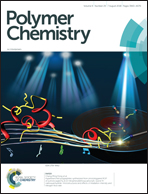Hyperbranched polypeptides synthesized from phototriggered ROP of a photocaged Nε-[1-(2-nitrophenyl)ethoxycarbonyl]-l-lysine-N-carboxyanhydride: microstructures and effects of irradiation intensity and nitrogen flow rate†
Abstract
Controlled polymerization to synthesize hyperbranched polypeptides (HBPPs) with tunable degree of branching (DB) and molecular weight (MW) is still challenging in synthetic polypeptides and their biomaterials fields. A new photocaged amino acid monomer Nε-(1-(2-nitrophenyl)ethoxycarbonyl)-L-lysine-N-carboxyanhydride (NPE-Lys NCA) was designed. Without the addition of any catalyst/initiator and/or scavenger, lysine-based HBPPs were directly synthesized from the UV phototriggered ring-opening polymerization (ROP) of NPE-Lys NCA by a one-pot method and at room temperature. Their branched structures were fully characterized by means of 1H NMR, 1H,1H-COSY, 1H,13C-HSQC, and quantitative 13C NMR techniques. The effects of irradiation intensity and N2 flow rate on the phototriggered ROP and MWs, DBs, and conformations of the resulting polypeptides were investigated. At a lower irradiation intensity of 0.3 mW cm−2, the actual MWs (Mw,LLS) of P1 to P3 increased from 34.9 kDa to 62.8 kDa when N2 flow rate shifted to 300 mL min−1; DB reduced from 0.43 to 0.21; and the α-helix content rose from 35% to 63%, while the random coil decreased from 50% to 26%. By tuning the UV irradiation intensity and/or the N2 flow rate, this methodology can efficiently produce lysine-based HBPPs with tunable DBs of 0.21–0.54 and higher actual MWs of 13.7–62.8 kDa.
![Graphical abstract: Hyperbranched polypeptides synthesized from phototriggered ROP of a photocaged Nε-[1-(2-nitrophenyl)ethoxycarbonyl]-l-lysine-N-carboxyanhydride: microstructures and effects of irradiation intensity and nitrogen flow rate](/en/Image/Get?imageInfo.ImageType=GA&imageInfo.ImageIdentifier.ManuscriptID=C8PY00641E&imageInfo.ImageIdentifier.Year=2018)


 Please wait while we load your content...
Please wait while we load your content...